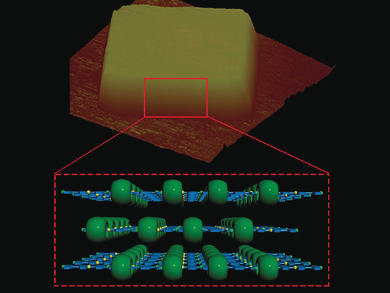Organic two-dimensional materials have applications in optoelectronics, catalysis, and biomedicine. The construction of such materials by supramolecular self-assembly is a useful approach because of the wide variety of possible building blocks and the precise structural control.
Liu Yu, Chen Yong and colleagues, Nankai University, Tianjin, China, have synthesized a highly ordered organic two-dimensional microplate assembly made of the macrocyclic host cucurbit[8]uril and an aromatic guest, i.e., a central phenanthroline moiety with two terminal 4,4′-bipyridin-1-ium units. The team combined the two components in equimolar amounts in an aqueous solution, which was then air-dried to give square microplates (pictured).
The material has peculiar electrical properties: It only conducts electricity one way and acts as a rectifier. The team found that the self-assembled microplate displays a good conductivity under forward bias, but is nearly nonconductive under reverse bias along the stacking direction. The ambipolar transport might arise from the small bandgap of the organic semiconductor material.
- Organic Two-Dimensional Assembly with Rectification Property Mediated by Cucurbit[8]uril,
Zhi-Yuan Zhang, Yong Chen, Ji-Wei Qi, Yu Liu,
ChemNanoMat 2019.
https://doi.org/10.1002/cnma.201800627




